The appearance of a variety of detergents and household products significantly made life easier for modern housewives. Despite this, when it comes to the question of how to clean a saucepan from serious contamination, usually folk remedies are used. Only they allow you to quickly remove the traces of fat inside and outside the product, to rid the objects of utensils from carbon deposits, scale and chronic burnt.
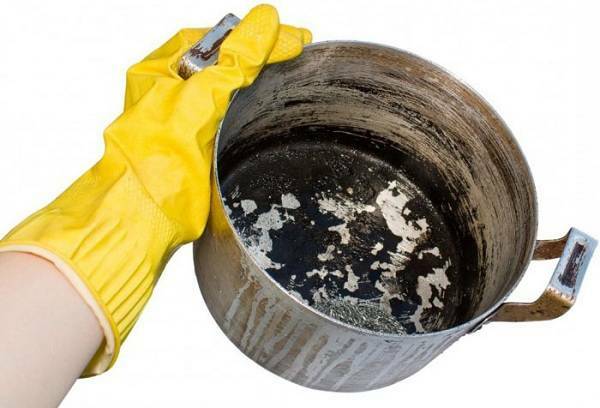
An additional advantage of this approach is the fact that even at home you can easily find a suitable effective tool. Only you need to understand that you can clean the burnt surface of a frying pan or pans without damaging it, only if you take into account the material features.
How correctly to process enamel ware?
It's very pleasant to cook in enameled dishes, but the food in it easily and quickly burns. Considering the fact that the enamel is quite sensitive to external influences, before removing traces of plaque, fresh cinders or calcareous scale from its surface, you need to choose the correct treatment option:
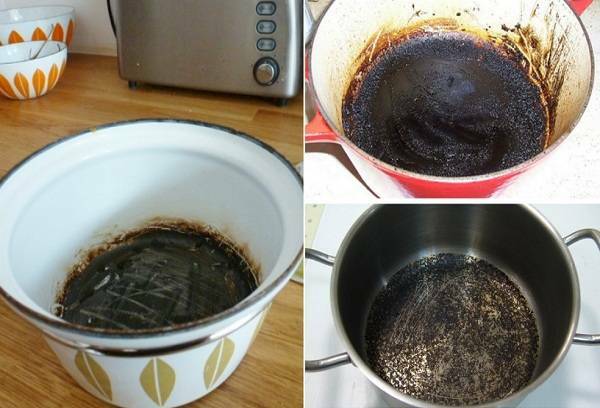
- Silicate glue and baking soda. With the help of this method, it is possible to clean any enamel ware from the contaminants, both inside and outside. We take a larger capacity than a spoiled item, pour water into it, cover half the packet of soda and squeeze out a tube of silicate( !) Glue. We mix the composition, bringing it to a boil. In the resulting paste we lower the functional part of the frying pan or saucepan, cook for a quarter of an hour. After that, all the deposit and scum can be removed without any problems by a soft sponge, holding the product under a stream of cold water.
- Activated carbon. To remove a thick layer of coke or grease without damaging the surface, 10 activated carbon tablets must be crushed to the powder state. The composition of a uniform layer is scattered across the area of contamination, we hold 20 minutes, then pour warm water. After a quarter of an hour you need to clean the enamel pot with a soft sponge and any detergent.
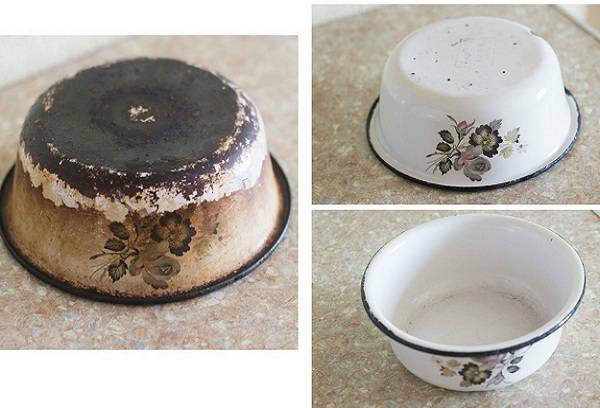
Tip: If the surface of the enamelware should be relieved of traces of burnt fat, you can simply pour the product for half an hour with a solution prepared from water and detergent. For greater effect, the composition must be heated to a very hot state and foamed with a whisk.
- Vinegar. Burned on the surface of a pot or frying pan, pour the food with a solution of vinegar and leave for two hours, after which it is processed in the usual way. If it is necessary to achieve a positive result quickly, then we put the dishes on medium fire and wait until the deposit begins to peel off from the surface. Remains of dirt remove sponge and detergent.
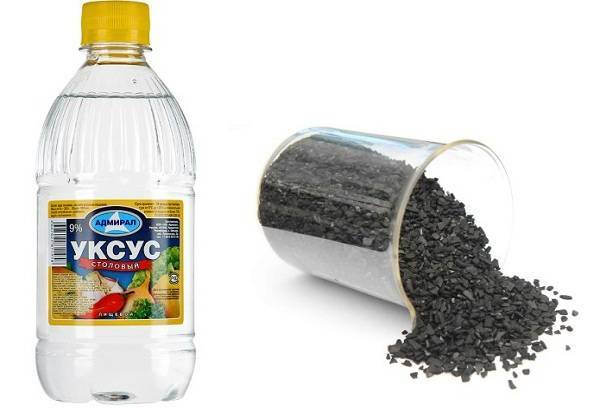
- Salt. If any of the reagents listed were not at hand, then there is always salt at home. In the pan where the food is burnt, pour a little water, fall asleep a couple of tablespoons of salt, stir and put on the fire. Boil the liquid for five minutes, pour out the water and try to get rid of the plaque with a soft sponge. A dense calcareous scale will not remove this method, but will save you from fresh burning or fat.

- Whiteness. If the situation is completely neglected, then you will have to use an aggressive chemical. Fill the bottom of the dishes with cold water, add a tablespoon of whiteness to it and leave for a day. After the specified time, you do not need to try to clean the enamel pan with the same composition, just merge it. In the tank, pour clean water( its amount should cover the volume of the cleaner), bring to a boil and merge. So repeat two more times. Clean the product thoroughly under running water.
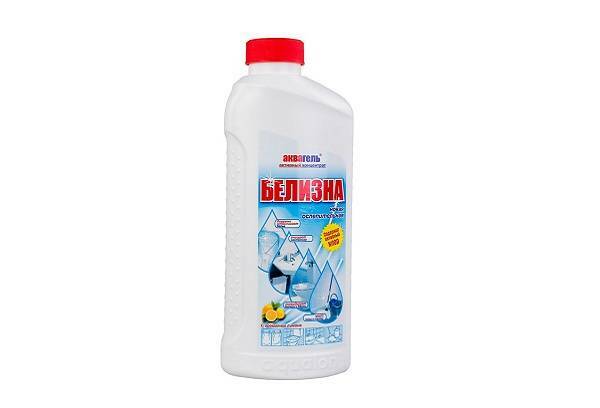
During the cleaning of dishes, extreme temperature changes should be avoided. Because of them, the enamel can crack and it will not be possible to restore the damaged surface.
Effective methods for cleaning aluminum utensils
Lightweight, unpretentious in the care and evenly distributing heat aluminum pans, saucepans and frying pans do not lose their popularity even against the background of modern appliances for cooking. Unfortunately, they are quickly covered with traces of burning and scale, which affects their appearance and functionality. Fortunately, experienced housewives have developed many options for restoring these products at home:
- Vinegar. This tool will help in case of fighting stains of fat and fresh traces of carbon deposits. Pour water into the aluminum container, add 9% vinegar at the rate of 4 tablespoons of product per liter of water. Boil the liquid for at least an hour, the mud should go away on its own. With the same means, the dishes made of aluminum can also be cleaned from the outside. We do not need to boil anything, just use a solution for rubbing the surface.
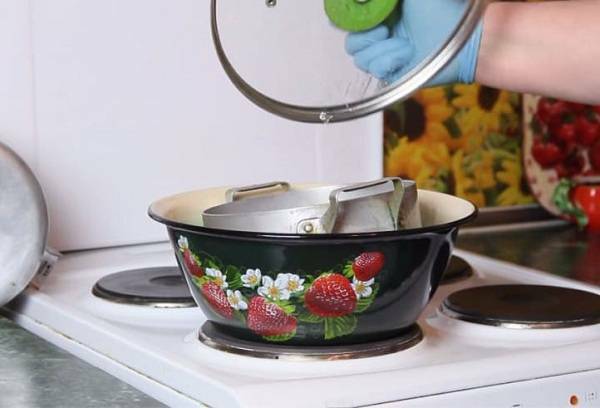
- Baking soda. If the aluminum pan is spoiled by a long cooking jam, then it should be boiled in a solution of baking soda( on a large saucepan it leaves from a third to a half of the pack of the product) for an hour. After such preparation, the carbon can be removed with a sponge gently and without problems.
- Citric acid. Allows you to clean frying pans and any other aluminum objects from scaling. Fill the tank with water, pour a little citric acid( no more than a tablespoon), stir and leave for an hour. Then bring the liquid to a boil and keep it on low heat for no more than 10 minutes.
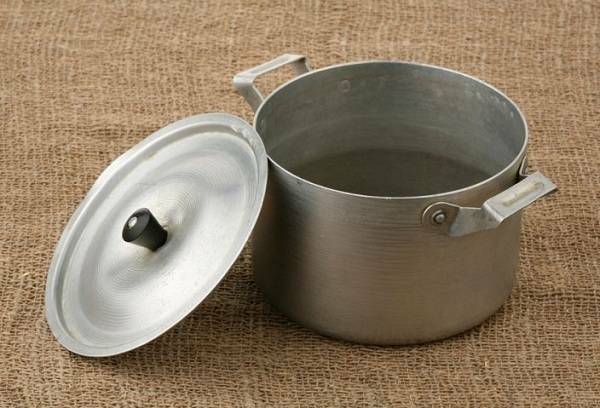
- Household soap. A dense layer of fat will not stay on the surface of the dishes if you pour water into it, dissolve the soap scraped soap and a little silicate glue. Boil the solution for half an hour, pour out, rub the metal with a soft sponge under cool running water to shine. Chalk or toothpaste. Also good to remove traces of scale and grease, covering aluminum objects. Just moisturize the surface and rub one of the reagents.
If cooking with the use of aluminum or enamelware is carried out in nature, then the fresh dirt should be rubbed with sand so that they do not turn into a thick coating.

